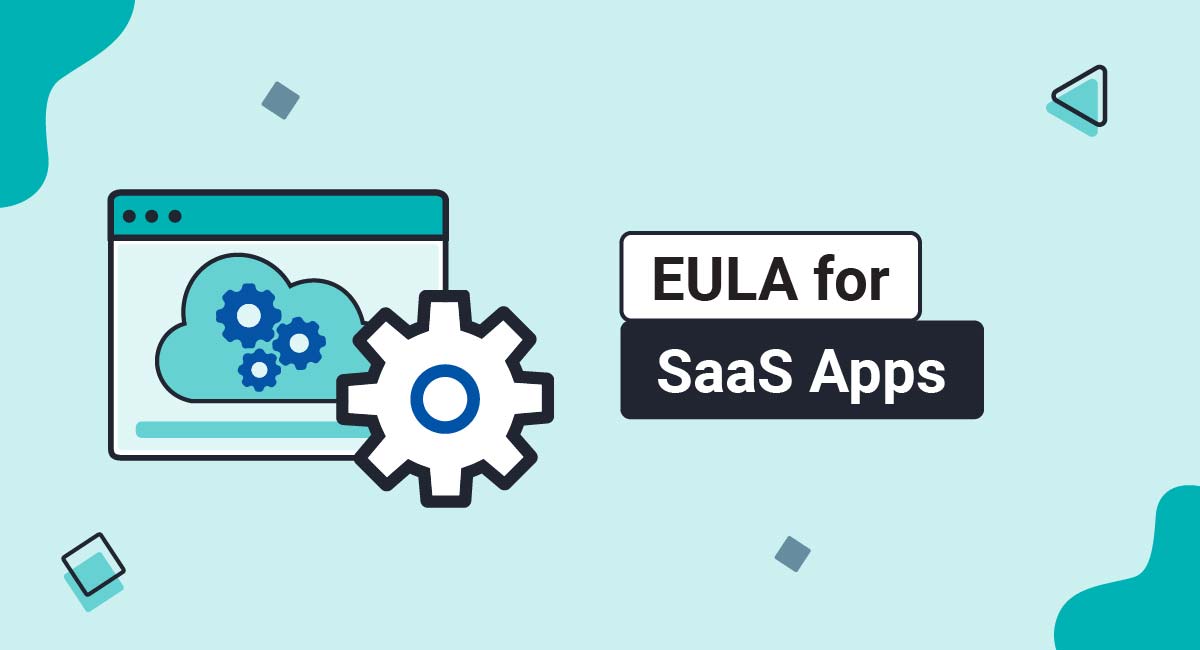An End-User License Agreement (EULA) is a legal agreement that gives the user of a software or application a license to use it, and the terms under which the granted license can be used. The EULA must be accepted before the user purchases, installs, or downloads the software or application from the service provider.
In this article you'll learn what an EULA is exactly, why you should have one for your SaaS app, what to include in yours and how to properly display one on your website and app.
Our EULA Generator makes it easy to create an EULA. Just follow these steps:
-
At Step 1, select the Desktop app option and click "Next step":
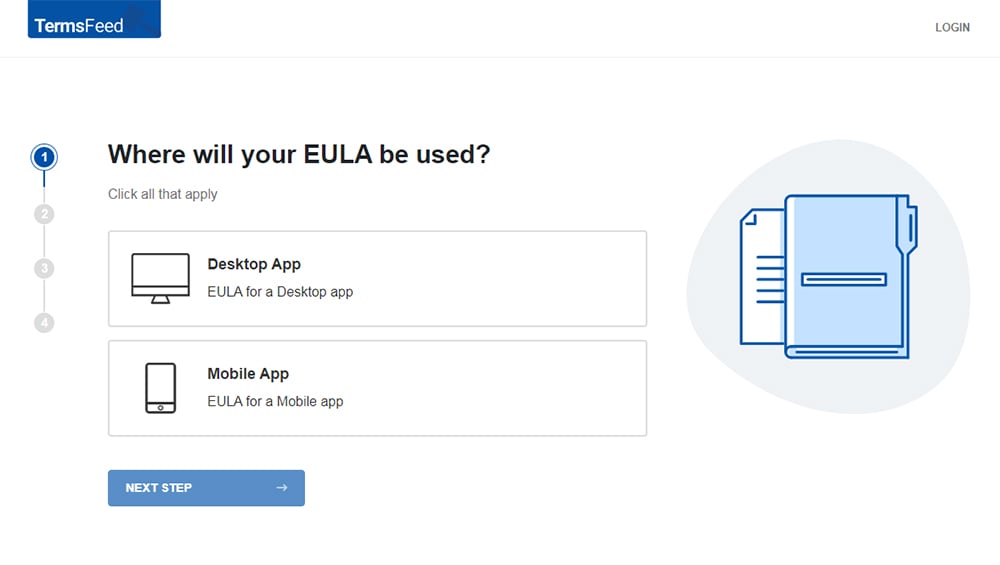
-
Answer some questions about your app.
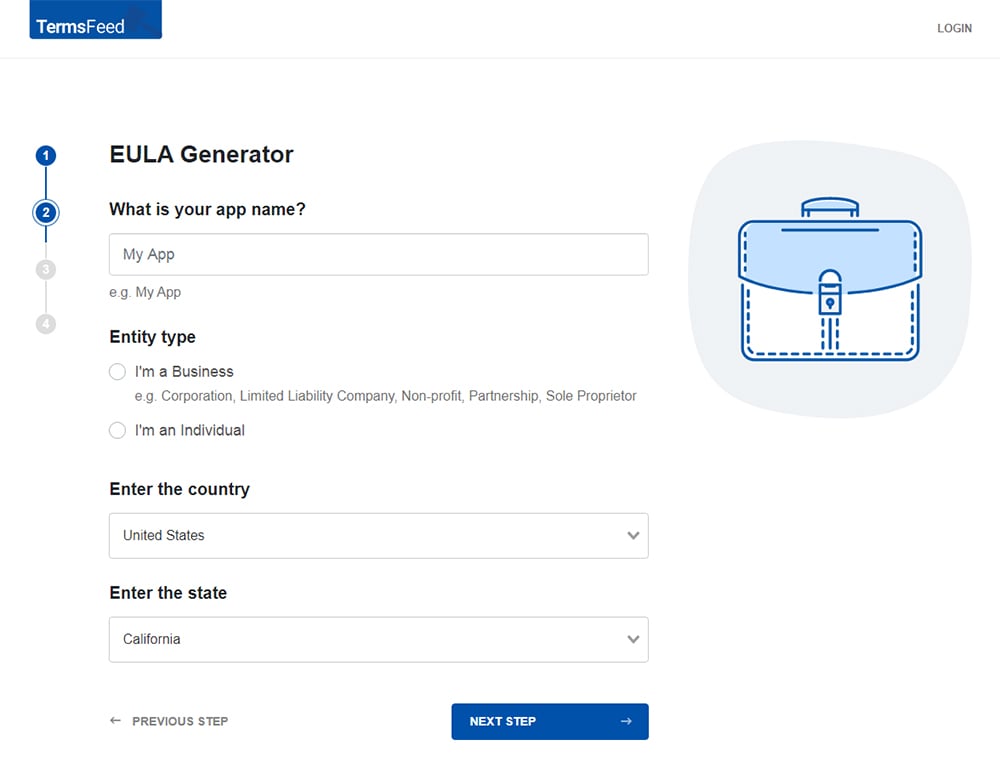
-
Answer some questions about your business.

-
Enter the email address where you'd like to receive the EULA document and click "Generate."

You'll be able to instantly access and download your new EULA.
- 1. What is an EULA?
- 2. Which Parties are Involved in an EULA?
- 2.1. The Software Owner
- 2.2. The Software Purchaser/End User
- 3. Is an EULA Required by Law?
- 4. Why SaaS Apps Should Have an EULA
- 5. How Does an EULA Protect Your SaaS App?
- 6. What Information Does an EULA Include?
- 6.1. Definitions
- 6.2. Granting a License
- 6.3. Restrictions of Use
- 6.4. Copyright and Intellectual Property
- 6.5. Warranty Disclaimer
- 6.6. Limitation of Liability
- 6.7. Related Agreements
- 6.8. Governing Law
- 6.9. Termination of Licensing
- 6.10. Software Updates
- 6.11. Licensor Contact Information
- 7. Where to Display an EULA for SaaS Apps
- 8. How to Get Agreement to Your SaaS App EULA
- 9. Conclusion
What is an EULA?
An EULA is a legally binding contract between the software service provider and end-users (the software buyers). This agreement grants customers a license to download, install, and use the application or software.
The EULA will include provisions about how buyers can use the software or app, what obligations they must meet, and what rights the provider retains as the seller. These clauses help to protect both parties in case of any disputes that may arise.
The agreement is typically presented to end-users during the process of installation. Like any other legal contract, both parties must agree to the terms before they are valid.
Here's an introduction of an EULA:

It's essential to note that SaaS is a subscription-based service. This means that users don't download the software onto their devices, and no local installations are required.
In other words, the end-user never has a copy of the software on their device. Therefore, SaaS can exist with or without an EULA.
Which Parties are Involved in an EULA?

EULAs represent the agreement between the software or app provider and the end user.
The Software Owner
You are the software provider if you own or create the software or app and sell the rights to use it to a target market. You may also be referred to as the publisher or developer.
Another more common name for a person who manufactures and sells products is a licensor because they hold the license for the product and allow individuals to use it.
The Software Purchaser/End User
The people who buy your software are called end users. In most cases, there are many end users because products are usually marketed to a large group of people. End users can be individuals or companies.
End users may also be called licensees because they buy the right to use your product.
Is an EULA Required by Law?
No law requires SaaS companies to provide their users with an EULA. Still, a proper EULA can help prevent legal problems in certain circumstances.
Why SaaS Apps Should Have an EULA

A SaaS app should have an EULA because it helps protect the company from misuse of its license, and allows the company to revoke access to abusive accounts. It also helps limit your legal liability while making your business look more professional.
As a SaaS company owner, there are specific instances when using a EULA is essential to protect your services.
For example, if you offer a mobile app version of your software, you should have an EULA. The EULA would give the person using your app permission to access it from their mobile device under your terms.
How Does an EULA Protect Your SaaS App?
A EULA's clauses establish the terms of the agreement with the primary legal protections offered being the following:
- Reaffirms your ownership rights in the software
- Explains rights conferred in license to user
- Restricts the use of the license
- Disclaims warranties
- Limits liabilities
- Describes license termination
- Helps protect your copyright and intellectual property
Additionally, an EULA might provide the software provider with some protection against lawsuits claiming the product harmed or damaged the user or their company.
What Information Does an EULA Include?

Different software providers will have varying priorities regarding the clauses they include in their EULA. However, there are some common EULA clauses that all software providers should include that address granting the license, restrictions on its use, warranty disclaimers, related agreements and others which we will look at below.
Additionally, you should ensure the agreement is written in easy-to-understand language so readers understand that they must agree to the contract's terms to receive a license to use the software or app.
Here are some of the common clauses that every SaaS App EULA should include.
Definitions
An EULA should have a clause listing important terms used within the agreement along with their respective definitions.
Here's an example of such a clause from Foleon:

Granting a License
Every EULA should have a clause at its beginning that grants the end user a license to use the product or service. Information about who made the software (the Licensor), what the software is for, and the date the EULA becomes active is typically included as well.
Additionally, it should be clear that the software or app provider only offers a license to use the product, and there is no transfer of ownership. In other words, the end user is being granted permission to use the product. They do not own it.
Microsoft's Virtual Desktop EULA has a clause on this subject that looks like this:
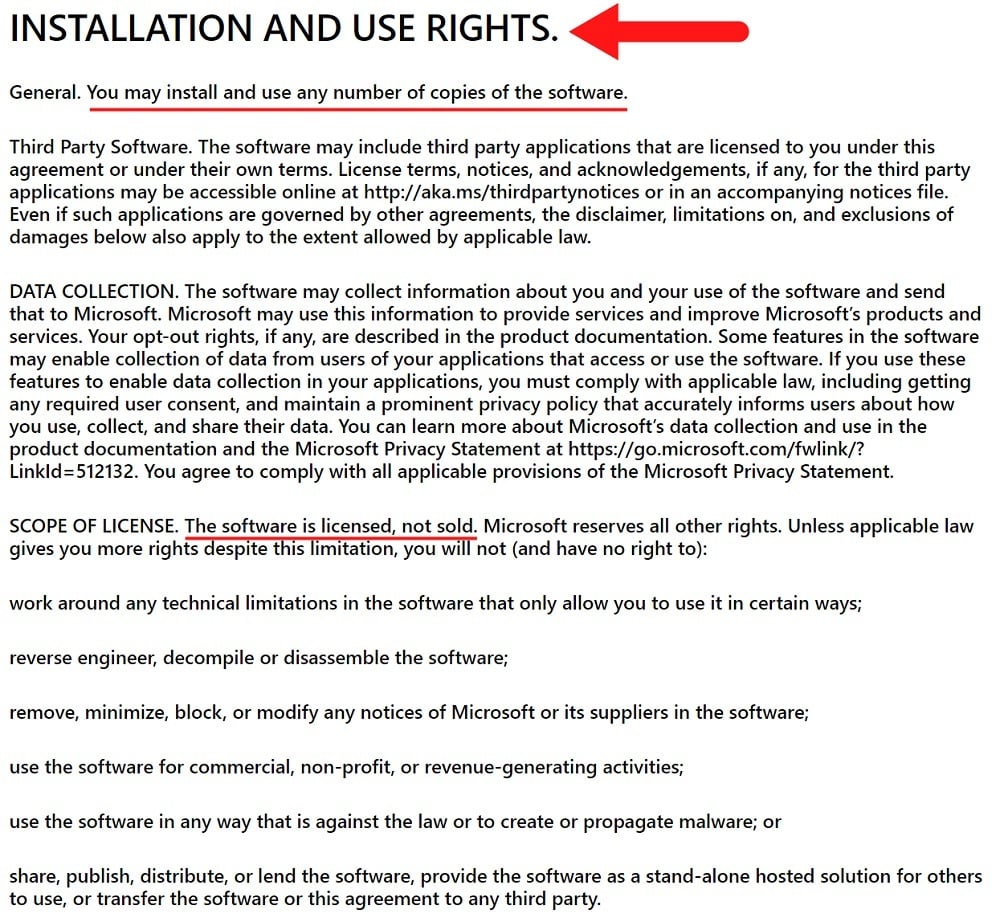
UBISOFT's first clause is one that explicitly grants a license. It outlines the scope of the license as being "non-exclusive, non-transferable, non-sublicensed, non-commercial and personal." It also notes that the product is licensed and not sold:

Restrictions of Use
This clause should clearly state how the user may not use the application or software. For instance, it should say that the user is prohibited from the following:
- Using the software in a way unintended by the Licensor
- Reverse engineering the software
- Copying or reproducing the software
- Using the software for illegal purposes
- Selling or distributing the software to third parties
Here's how Microsoft's EULA outlines what users must not do (have no right to do) with the granted license:

Copyright and Intellectual Property
This clause will let users know that you are claiming all copyrights and IP rights in your product. It can be as simple as stating that you "have and retain all rights, titles, and interests" in your copyright and IP.
Here's an example from Appfire:
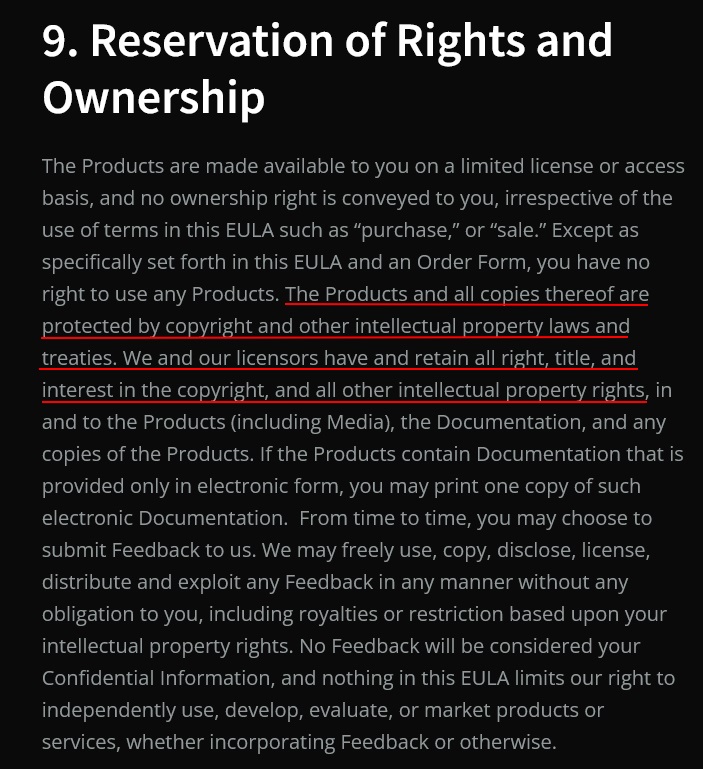
A clause like this also works to protect your creative and created content by clarifying to users what could happen if they infringe on your copyright and break your rules.
For instance, if someone uses your software in a way that breaks your copyright, you could sue them.
UBISOFT includes an "Ownership" clause that lists out all the types of content that it maintains full ownership rights in, including text, graphics, music, fictional characters, costumes, dialogues, slogans, domain names and more:

Warranty Disclaimer
It's common practice to disclaim all warranties in order to protect yourself from liability. You can do this by simply stating that the software is offered "as is." Do not make any guarantees about the outcome of your product's services or functionality. Consequently, if the product does not perform as advertised, you cannot be held liable for damages incurred by the user.
Here, SwifDoo makes certain the user understands the product is provided "as is":

Limitation of Liability
The limitations of liability clause in your EULA is where you state that you cannot be held responsible for any damage caused by your software. Be as clear and concise as possible.
Examples of the types of damages you would want to limit liability for include:
- Loss of business reputation
- Malfunction of software
- Personal injuries
- Property damages
As you can see below, this EULA has a clause that limits damages that could arise from all the above:

Related Agreements
You should add a section to your EULA that informs users that they also agree to other terms and agreements that your company has, such as your Privacy Policy or Terms and Conditions agreement.
Here's how UBISOFT incorporates both its Privacy Policy and Terms of Use into its EULA in the introduction clause:

And here's how Blackbird does it:

Governing Law
In this clause, you need to list the governing law of the EULA. Governing law is the law that the agreement will be interpreted under if a dispute arises.
You may wish to pick the state where you do the most business or are incorporated.
This clause declares governing law is the State of Texas:
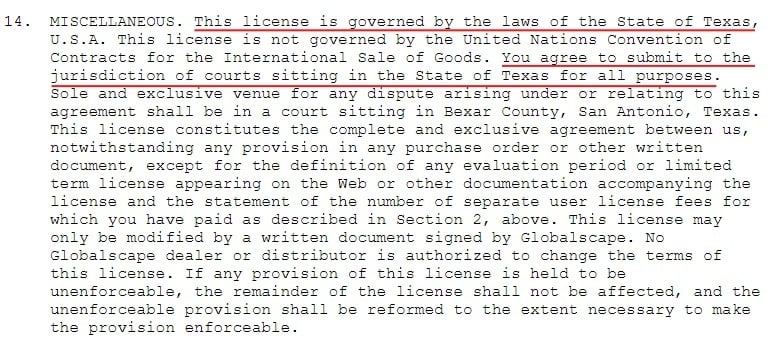
Termination of Licensing
In this clause, the software provider reserves the right to terminate the end-user's license to use the product. For instance, if the software was used in a manner prohibited by the "restrictions of use" clause, the provider has grounds to terminate the end-user's license.
Here's an example of a clause that explains what happens when the license is terminated:

Software Updates
This clause informs users that the software or app creator may periodically update the product. These updates may be automatic, and they might include such things as fixes for glitches and bugs or feature add-ons.
The following clause lets users know what happens if there are updates, including which version of the EULA will apply when updates are made:

Licensor Contact Information
You should include a section at the end of your EULA with contact information for customer service or legal department personnel who can answer inquiries about the agreement. You should also provide a mailing address, email address, and telephone number if possible.
The following clause includes a variety of ways a user can contact the company at the end of its EULA:

Spotify doesn't include specific contact information, but it does let users know where they can find that information on the website:

Now that you see what key components should go into your SaaS app's EULA, let's look at where to display it once you have it drafted.
Where to Display an EULA for SaaS Apps

You should make your EULA clear and visible to users by placing it in a conspicuous place both outside and within the app. Outside the app could be within a website footer so a user can access it before downloading the app. Within the app can be in an in-app menu.
Here's how Movavi displays a link to its EULA in its website footer:

This allows for access to the EULA at any time, without needing to download the app first.
Here's another example from the Elder Scrolls online game:
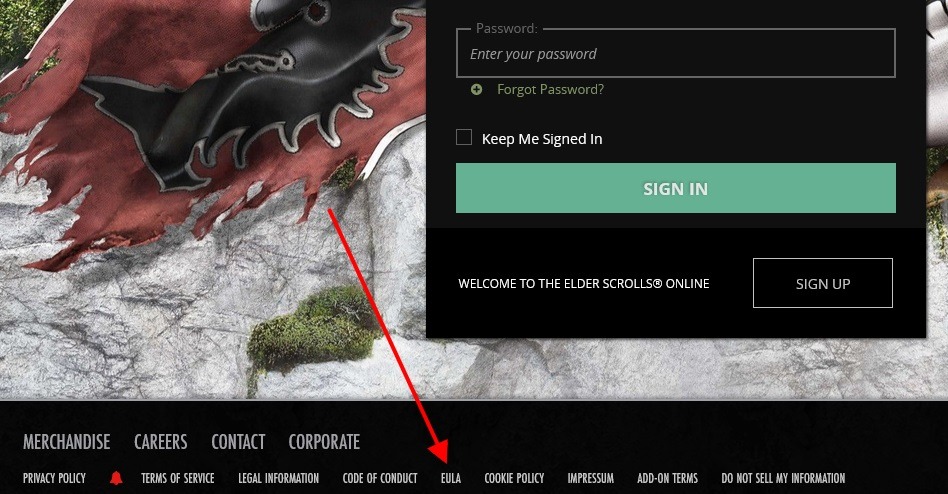
Make your EULA available within your app itself as well, such as in a "Legal" or "About" menu.
Here's how Opera links its EULA within its app along with its other important legal agreements:

Along with displaying your EULA, you'll need to get users to agree to it. Let's look at how you can do that.
How to Get Agreement to Your SaaS App EULA

If your users don't agree to your EULA, they would not be legally bound by its terms, and you would be unable to enforce the agreement.
Therefore, you need to get whoever is purchasing and downloading your mobile app to accept your EULA. They need to provide explicit, active consent. The best way to ensure that is by providing the buyer with an opt-in method.
The "click to accept" method is the most common way of getting users to agree to your EULA. This acceptance method is typically called "clickwrap." It requires that a user clicks on something - a checkbox, a linked button - that shows their active intention to accept or agree to your agreement.
Here's an example from BabelEdit that shows how users must actively click a button labeled "Agree" to agree to the terms:

TeamViewer takes a similar approach but uses a checkbox a user must check to show they agree before continuing with the installation:
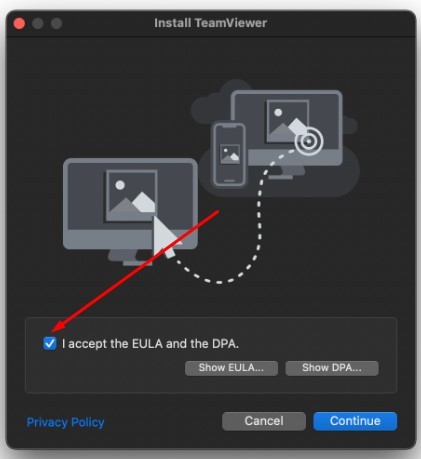
Conclusion
Having an EULA for your SaaS app can help protect you from legal liability while keeping your users informed about some of your requirements and restrictions for using your app.
Include information in your EULA about the following:
- The scope of the license you're granting
- Restrictions on use of the license
- Warranty and liability disclaimers
- How and when a license may be terminated by either party
- What law governs your EULA
- How users can contact you
Make sure to display your EULA in a way that people can view it both before they download your app, as well as from within your app itself.
Get clear agreement to your EULA via a checkbox and "I Agree" button to ensure your EULA is legally binding and able to be enforced if needed.

Comprehensive compliance starts with a Privacy Policy.
Comply with the law with our agreements, policies, and consent banners. Everything is included.
